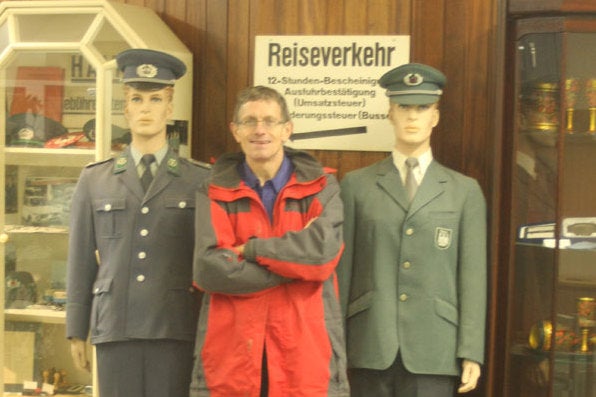International travel corridors? They’ve been around for centuries
The Man Who Pays His Way: Before the fall of the Wall, the only way was along the corridor

Your support helps us to tell the story
From reproductive rights to climate change to Big Tech, The Independent is on the ground when the story is developing. Whether it's investigating the financials of Elon Musk's pro-Trump PAC or producing our latest documentary, 'The A Word', which shines a light on the American women fighting for reproductive rights, we know how important it is to parse out the facts from the messaging.
At such a critical moment in US history, we need reporters on the ground. Your donation allows us to keep sending journalists to speak to both sides of the story.
The Independent is trusted by Americans across the entire political spectrum. And unlike many other quality news outlets, we choose not to lock Americans out of our reporting and analysis with paywalls. We believe quality journalism should be available to everyone, paid for by those who can afford it.
Your support makes all the difference.A stranger passing strangely through a strange land: that was how it felt the first time I experienced a real international travel corridor – across Cold War Europe.
I have written (and you, poor reader, may have read) a vast amount about the worst quarantine policy in history: Britain’s bizarre blanket requirement to self-isolate for two weeks even after returning from locations such as the Azores, an Atlantic archipelago with nil coronavirus cases.
Besides unplugging the life-support machine to which the UK travel industry is currently attached, the policy is dissuading healthy British holidaymakers reaching places where they are much less likely to contract Covid-19.
Belatedly, the government is seeking to limit the damage caused by this absurdly heavy-handed approach by brandishing the idea of reciprocal no-quarantine policies: “We won’t make people from your country sit in a room for 14 days if you allow ours the same privilege.”
Ministers originally branded these deals “air bridges”, before remembering that some travellers arrive by rail or sea. So now they are “international travel corridors”, as though this were some novel term.
In fact, international travel corridors have been around for centuries, in the shape of thoroughfares crossing foreign territory.
High in the Pyrenees, the Spanish town of Llivia dangles by a thread from the rest of Catalonia – almost entirely encircled by French territory.
The 1659 Treaty of the Pyrenees obliged the Spanish-speaking villages on the French side of the watershed became part of France. But since Llivia was officially a town, it was not covered by the ruling. A geo-political oddity it may be – but it is distinctly Spanish, with lower prices to match. It remains connected to the “mainland” by a two-mile corridor known as the N-154.
Anyone touching down at the “Swiss” airport of Basel is actually in France. To reach the city named on your plane ticket, you must travel along the Zollfreie Strasse – “customs-free road”. I can testify that if, as a pedestrian, you need to swerve away from this international travel corridor (for example to reach the French railway station of St-Louis), hopping over the fence is not a challenge of Berlin Wall proportions.
Talking of which: the most intricate and forbidding international travel corridors in history were those connecting West Germany with West Berlin.
A quick reminder of tortured post-war geography of central Europe. The victorious Allied leaders carved up what remained of Germany into British, American, French and Soviet sectors.
The Western allies’ territories coalesced into West Germany, while the Soviet sector became East Germany – a totalitarian state in the pocket of the Kremlin.
Hitler’s capital, Berlin, lay deep inside the Soviet sector, and was regarded as so symbolic that that the city itself was similarly divided. The British, US and French parts unified as West Berlin – connected with the “mother country” by corridors through the German Democratic Republic.
The Autobahnen linking West Berlin with Munich, Hannover and Hamburg were the designated arteries, but they were also open to “local” traffic. Sputtering Trabants were overtaken by gleaming Mercedes, hammering home the economic order to long-suffering East Germans.
Gliding comfortably along in those Mercedes was, usually, a hitchhiker or two. You know Checkpoint Charlie, of course: the city-centre crossing that symbolised the frontline of the Cold War. Its less celebrated cousin was Checkpoint Bravo, also known as Dreilinden frontier post, on the edge of the city where West Berlin met East Germany.
Today it is a curious museum to a distant age. But up to 1989, it was the hitchhiking hub of Europe.
Because of the camaraderie created within a hermetically sealed city, this border crossing quickly became the finest place in Europe for hitching. Scrawl a sign with H, HH or M – the city codes on number plates – and you were guaranteed a lift within seconds to Hannover, Hamburg or (my choice) Munich.
Hitchhiking on demand: it was a weird world. Rather like today.
Join our commenting forum
Join thought-provoking conversations, follow other Independent readers and see their replies
Comments